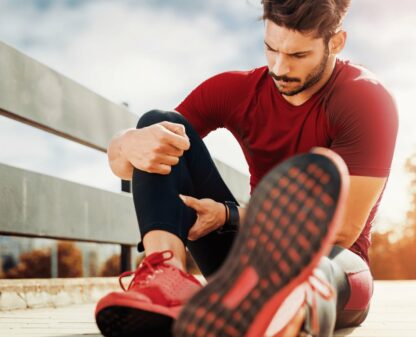Association of Ankle Plantar Flexor Strength with Balance and Walking Speed

Introduction
Balance is essential for walking and a loss of balance may cause slower walking speed and increase the risk for falls. On the other hand can a decreased balance lead to an increased injury risk. The plantar flexors of the ankle are important force producers and it is thought that a decreased strength contributes to an ineffective push-off and reduced walking speed. This review investigates the association between plantar flexor strength and balance and walking speed.
Methods
A systematic review and a meta-analysis was done according to the rules of art. Cross sectional designs were included since the authors postulated this was the most appropriate design to answer their research question.
Strength of the calf was measured through maximal isometric contraction and maximal isokinetic contraction and endurance (heel-raise test). Balance was measured with instruments such as force platforms and divided into static and dynamic balance. Measures of static balance were documented with single and double leg stances or during a tandem stance with or without visual feedback. Dynamic reactive balance was measured while standing on a dynamic force platform or during a forward induced fall. Walking speed was measured by the preferred walking speed and maximal walking speed.
Outcomes were pooled according to the age categories “young adults” (18-40y), “middle-aged adults” (40-60y) and “older adults” (>60y).
Results
Isometric plantar flexor strength
The association between isometric plantar flexor strength and static balance was studied in young, middle-aged and older adults. Only in older adults a weak effect was found, supported by strong evidence.
Fordynamic reactive balance (the ability to control balance during an unpredicted perturbation) a moderate association supported by strong evidence was found between plantar flexor strength and balance during a forward induced fall in older adults. A moderate level of evidence shows a moderate association between plantar flexor strength and proactive balance (the ability to control balance during a predicted perturbation) in older adults.
Isokinetic plantar flexor strength
When plantar flexor strength was measured isokinetically, only in older adults a moderate association was found in static and dynamic balance, but this was supported by limited evidence. The heel-raise test served as the isokinetic plantar flexor strength measurement.
Walking speed
Considering walking speed, only in older adults a weak association, supported by strong evidence, was found between maximal walking speed and preferred walking speed and isometric plantar flexor strength.
After sensitivity analyses, more heterogeneity was found in the association between dynamic proactive balance. When excluding studies measuring strength with hand-held dynamometers, associations with maximum walking speed and preferred walking speed were increased, with important reductions in heterogeneity.
Questions and thoughts
The review investigated balance and walking speed in healthy individuals. However a closer look at the included participants reveals that in some of the studies participants had knee osteoarthritis, foot pain or a history of previous falls. This could have influenced the findings. Not all of the included studies controlled for confounding factors, which could have been important since balance is a difficult sensorimotor task, potentially influenced by several factors. A very important aspect when interpreting these findings is that since the included studies were cross-sectional, no causational relationships can be established.
Pooling was performed with participants of similar age, which is necessary as age is inversely associated with muscle strength, balance, and walking speed. However, not every age group was represented just as much. Of a total of 2673 people included in this review, 447 participants were young, only 74 participants were middle-aged, and 2152 participants were older. So it seems that older populations were represented more, which could explain why findings are generally more pronounced in older participants.
Talk nerdy to me
Since databases were searched from inception on, it is very likely that the search included all relevant articles. Two reviewers independently screened for eligibility, and data was extracted by one of the researchers and checked for accuracy and completeness by the second one. Risk of bias was assessed by the two reviewers independently. So nothing much to say here.
Take home messages
As this review showed that the associations between calf strength and balance are mostly supported by conflicting evidence, currently no recommendation for strengthening of the ankle plantar flexors to improve balance and walking speed can be made. A factor that may cause this lack of association can be assigned to the differences in balance measures. When hand-held dynamometers were excluded from the results, more heterogeneity was found. This should be taken into consideration when evaluating balance in clinical practice or in future studies.
Based on moderate to strong evidence, isometric plantar flexor strength is moderately associated with dynamic balance in older adults, compared to no or mild association with static balance. This could mean that plantar flexor strength is more important in more challenging tasks. Isokinetic plantar flexor strength (measured by the heel-raise test) is moderately associated with static and dynamic balance in older adults. Plantar flexor strength is weakly associated with walking speed.
Reference
WHAT TO LOOK FOR TO PREVENT HAMSTRING, CALF & QUADRICEPS INJURIES
Whether you’re working with high-level or amateur athletes you don’t want to miss these risk factors which could expose them to higher risk of injury. This webinar will enable you to spot those risk factors to work on them during rehab!



